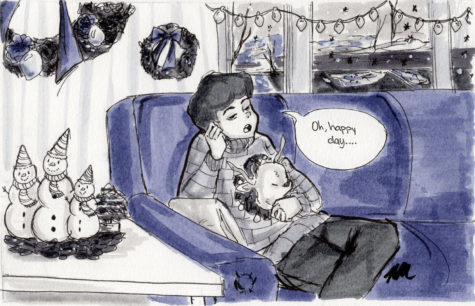Dealing with the Winter Blues
December 12, 2019

Seasonal Affective Disorder can make it difficult to enjoy the holidays.
The winter season is generally a time where people can come together in good cheer and share happiness. However, to some, the gift giving, the shining lights of holiday decor and the winter weather may cause strain and usher in seasonal affective disorder among individuals.
Sophomore counselor Jenney Myler says SAD is a type of depression that correlates with the seasons.
“[It] typically starts in the late fall and early winter and goes away during the spring and summer,” Myler said. “Depressive episodes linked to the summer can occur, but are much less common than winter episodes of SAD.”
Senior Laurel Koenigsfeld is affected by SAD. Although having symptoms in the summer are possible, Koenigsfeld is affected during the winter months.
“It depends on the person,”
Koenigsfeld said. “For me personally, it starts right around the end of November and goes through January.”
The occurrence of SAD is quite common. According to Psychology Today, SAD affects more than 10 million Americans.
“The age of onset seasonal affective
disorder is estimated to be between the ages of 18 and 30,”
Psychology Today said. “Some people experience symptoms severe enough to affect the quality of life, and six percent require hospitalization.”
Koenigsfeld said a lack of Vitamin D can contribute to the disorder. During the colder months, the days are shorter and the nights are longer. Sometimes people will not receive enough
sunlight, causing Vitamin D deficiency. Vitamin D deficiency can lead to low immune system, fatigue, and
depression — which are symptoms of SAD.
“SAD can also be caused by the stress of relatives that someone might not necessarily feel comfortable with,” Koenigsfeld said.
Traveling and the process of shopping for a multitude of people can sometimes help bring out the symptoms of SAD or make them worse.
The symptoms of SAD varies for every person and has a wide range of affects. Some symptoms include poor appetite, weight loss, insomnia, agitation and anxiety.
“SAD may also include some of the symptoms that occur in major
depression, such as feelings of guilt, a loss of interest or pleasure in activities previously enjoyed, ongoing feelings of hopelessness or helplessness, or physical problems such as headaches and stomach aches,” Psychology Today said.
Koenigsfeld has experienced extreme fatigue, as well as anxiety from the travel.
“As someone who deals with genetic depression, seasonal depression tends to just add more to what I already have to deal with,” Koenigsfeld said. “Generally my depression is relatively manageable but, SAD creates an unsatisfactory fatigue. At one point the fatigue was so strong that I slept for three days straight and was still tired when I was forced awake. I put sleep above eating, showering, school, family, and friends. Nothing is enjoyable because I’m just so tired and the feeling lingers for days. It can really create a sense of powerlessness in those who deal with SAD.”
Myler agrees and says it’s important to recognize symptoms early.
“Some of the most concerning symptoms include feelings of
hopelessness, anxiety, and insomnia,” Myler said. “These symptoms could make it difficult to maintain a healthy mind and body.”
There are multiple treatments and ways to receive help for SAD.
“Because winter depression may be a reaction to a lack of sunlight,
broad-band light therapy is frequently used as a treatment option,”
Psychology Today said. “This therapy involves exposure to bright artificial light that mimics outdoor light for a period of time in the morning.”
Myler also recommends seeking treatment if necessary. Some ways to set up receiving help would start with diagnosis.
“Diagnosis and treatment should come from a medical or mental health professional. The most common types of treatments include medication, light therapy, psychotherapy, and/or vitamin D supplements,” Myler said.
Koenigsfeld also supports receiving the attention of trusted adults to help cope and receive the correct plan to help combat SAD. She also provides information on some ideas of where to begin with help.
“One of the most simple tricks to deal with SAD is to start taking a vitamin D supplement; this can help with the fatigue and depression,” Koenigsfeld said. “If the symptoms are exacerbated by certain family members, then be sure to get alone time and do
something quiet and relaxing. Things can get hectic around the holidays and being in close quarters with family members may not benefit your mental health. Taking time to decompress, even for 10 minutes a day, can make a huge impact.
“Decompressing can include communicating with and ranting to friends, watching Netflix, taking a bath, or taking a nap. If the symptoms of SAD are unmanageable, then please talk to a parent or counselor. Chances are that they will understand the frustration of the holidays, even if they don’t fully grasp the effects of seasonal depression.”
Self care is also an important task in improving one’s mood.
With the numerous amount of treatment plans being provided, it allows individuals to receive the help they desire.
“Monitor mood and energy levels, take advantage of the available
sunlight, plan pleasurable activities for the winter season, plan physical
activities, approach the winter season with a positive attitude,” Psychology Today said. “When symptoms develop, seek help sooner rather than later.”





